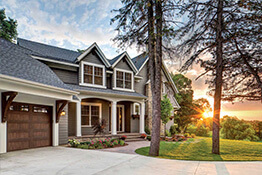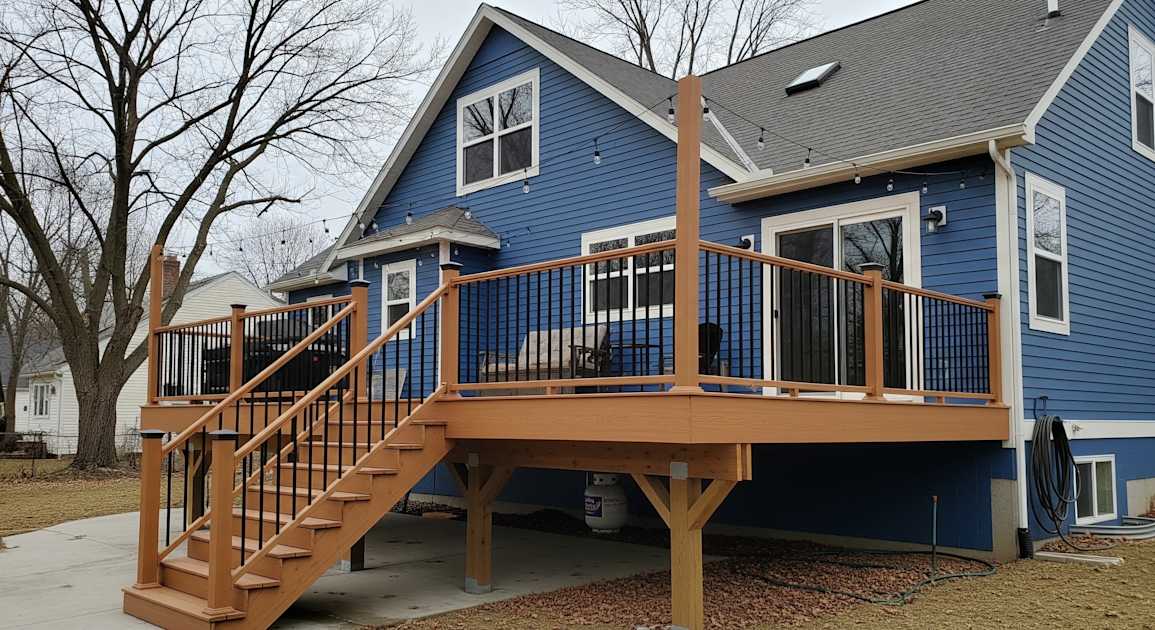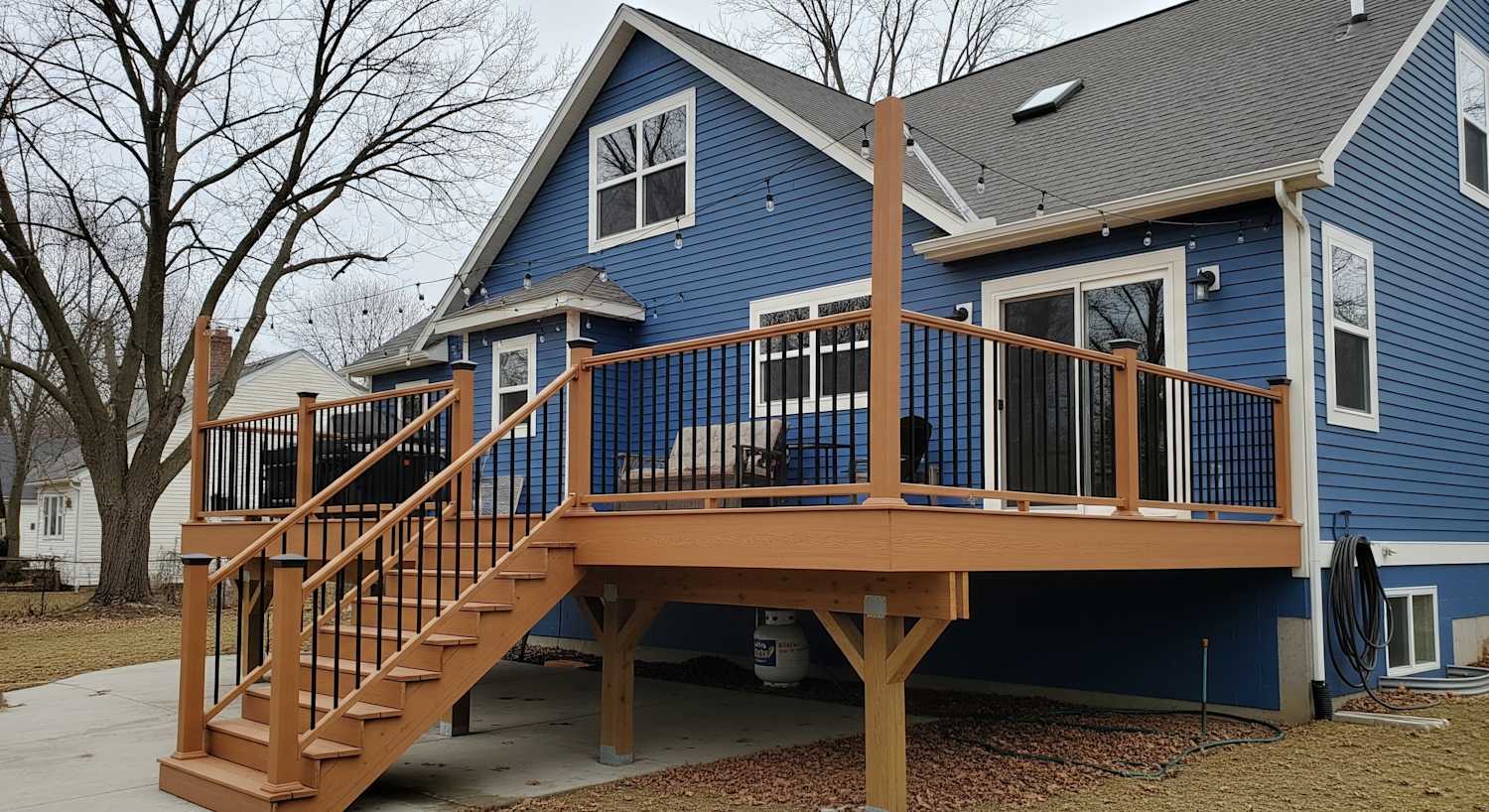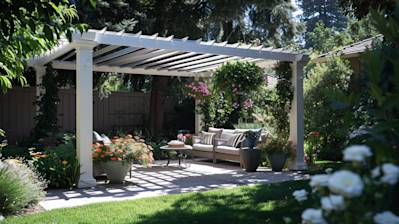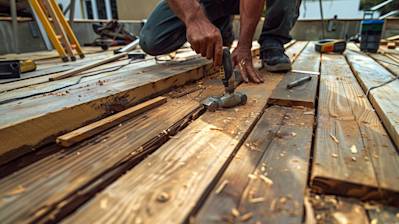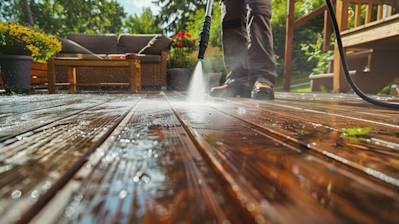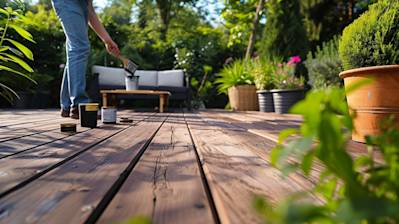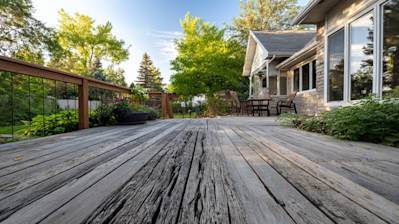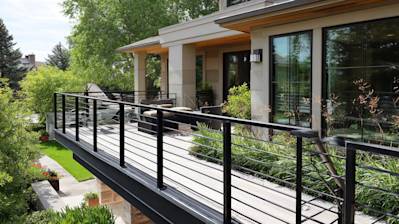Offering a striking path between different levels, deck stairs can transform any deck, porch, or patio. Choosing the right design, materials and construction techniques can create a seamless transition between your outdoor spaces. Let's explore everything you need to know about deck stairs to elevate your outdoor living experience.
Defining Deck Stairs
Deck stairs, or staircases, are a vital component of any multi-leveled outdoor area. They provide a safe and practical solution to navigate from higher to lower areas or vice versa. But they aren't all just function – the right deck stairs can give your outdoor area a unique design feature that enhances your space's aesthetics.
Vital Elements of Deck Stairs
To build the best deck stairs for your space, it's important to understand the key components.
- Treads: These are the horizontal pieces you walk on. Their width influences your stride, affecting the comfort and safety of your stairs.
- Risers: The vertical boards between each tread. These can be open or closed depending on the style you prefer.
- Stringers: These are the supportive spine of stairs, carrying the weight of people walking on them.
- Railings: A safety requisite on all stairs with multiple steps, railings can also reflect your style.
- Landing: Depending on your staircase's height, you may need a landing – a flat area where the stairs change direction.
Selecting Materials for Deck Stairs
The materials you choose can impact the overall feel, longevity, and upkeep of your deck stairs. Here are several material options:
- Wood: A traditional, versatile choice, wood can offer a wide range of aesthetics, but needs regular maintenance.
- Composite: This offers the look of wood without the maintenance. It's durable, but more pricey.
- Metal: Modern and stylish, metal is long-lasting and requires minimal upkeep. However, it can be slippery when wet.
Deck Stairs Design Guide
The design of your deck stairs can transform your outdoor living area. Whether you opt for traditional straight stairs, sleek spiral stairs, or ornate curved staircases, the design should reflect your home’s character. Next, let's look at some popular deck stair designs:
- Straight stairs: Simple and functional, straight stairs are the most common and easiest to build.
- L-shaped stairs: These stairs have a landing in the middle, providing the opportunity for a direction change or enhancing visuals.
- Spiral stairs: A fantastic space-saving solution, spiral stairs are fun, stylish, and make a strong impact.
- Curved stairs: Dramatic and elegant, curved stairs are visually impressive but also the most difficult to build.
Building Deck Stairs: Step-By-Step
Building your deck stairs can be a rewarding DIY project. Below are essential steps:
- Planning: Determine the number of steps, riser height, and tread depth consistent with standard safety recommendations.
- Marking Position: Mark out the exact location of your stairs, ensuring it doesn't interfere with your outdoor activities.
- Building Stringers: Use a quality board and precise measurements to cut your stringers.
- Installing Stringers: Affix the stringers to your deck using stair hangers for robust support.
- Adding Treads & Risers: Install treads and risers, ensuring they're secure.
- Adding Railings: Install railings that match your deck, ensuring they're secure and have comfortable handgrips.
Frequently Asked Questions about Deck Stairs
What materials are best for deck stairs?
The ideal materials for your deck stairs largely depend on the existing structure and the aesthetics you're trying to achieve. That said, treated wood is often a popular choice thanks to its durability and affordability. Composites can be a great option should you want something with minimal maintenance. Metals like aluminum or steel can provide a sleek and modern look and have significant longevity.
What regulations exist for deck stairs?
Regulations for deck stairs can vary, depending on where you live. It's a good idea to check with your local building department before starting. Things that commonly come under regulation include the width, depth, and the rise and run of your steps, handrails requirements, and certain safety considerations.
How often should deck stairs be replaced?
The lifespan of deck stairs can greatly vary based on the materials used, the quality of the construction, weather conditions, and how well they're maintained. However, as a rule of thumb, most deck stairs should be inspected every year. Any visible signs of weakening or deterioration would call for immediate replacement.
What are the common problems with deck stairs?
Common problems with deck stairs can include warping, cracking, or rotting of the wood. Sometimes, the stairs can also become unstable due to issues with the stringers or they weren't properly attached to the deck. Loose or broken handrails are another concern. Regular inspection and maintenance are key in preventing these issues.
How should I maintain my deck stairs?
To maintain your deck stairs, make sure you clean them regularly to prevent grime build-up. Reapply protective sealant or paint on wooden stairs every year to help prevent wear and tear. Check and tighten any loose bolts or screws and replace any rotting or damaged parts when necessary.
Do deck stairs need railings?
By law, most areas require a railing when the deck stairs are above a certain height (typically around 30 inches). More than just meeting local codes and regulations, railings provide added safety, helping to prevent accidents.
What type of lighting can be used for deck stairs?
There are various lighting options suitable for deck stairs, including recessed stair lights, riser lights, or even post lights. Choose an option that suits the style of your deck and provides sufficient illumination for safe navigation of the stairs at night.
Can I build deck stairs with landing?
Yes, deck stairs can be built with a landing. In fact, landings can make navigating the stairs easier and safer, particularly if you have a high deck. They can also provide a nice place to pause and enjoy your outdoor space.
Pros of Deck Stairs
Accessible Entrance and Exit
One of the biggest advantages of deck stairs is the ease of access they provide to the deck area. Depending on how your house is situated, these stairs can provide a direct and straightforward path from the deck to the backyard or garden. They act as a transitional point between your living area and your outdoor space.
Add Dimension to your Home
Deck stairs not only give additional structure to your deck, but they also add an aesthetic appeal by adding an extra dimension to the deck and overall house structure. The stairs can give depth to a flat yard, making it visually appealing.
Customization
Deck stairs offer great customization options. They can be of any size, shape, and made from a variety of materials. The stairs can be designed to match the architecture of both the house and the deck. For example, if your home has a rustic look, you can choose wooden stairs. If modern minimalism is more your style, you can opt for metal or concrete stairs.
Flexibility in Design
Whether your deck is low or high, small or spacious, deck stairs can be designed to fit the space perfectly. The steps can be wide for a grand look or narrow for more compact areas. Moreover, you can decide if the stairs will run straight down or take an L or U shape.
Increases Home Value
Deck stairs are more than just a convenience or aesthetic feature—they can add value to your home. A well-designed, visually appealing deck with easy access through the use of stairs increases your home's resale value.
Security
Deck stairs, when designed with appropriate railings and lightings, can provide security by physically outlining the area and making it less attractive to intruders.
Cons of Deck Stairs
Maintenance
One of the significant downsides of deck stairs is the maintenance they require. Paint and stain wear off over time, often faster on stairs due to heavy foot traffic. Wooden stairs can rot, splinter, and get damaged by pests. Metal stairs, on the other hand, can rust. Concrete stairs can crack. To keep the stairs safe and attractive, regular maintenance is necessary.
Safety Hazard
While deck stairs do provide easy access, they can also become a danger if not properly taken care of. Loose railings, broken steps, or poor lighting can lead to accidents. They also pose a likely safety concern for households with seniors or young children.
Installation Cost
Deck stairs are not cheap. Depending on the design, material, and builder you choose, the cost of adding stairs to your deck can range from modest to noteworthy. Also, as mentioned earlier, there is an ongoing cost associated with maintenance and repairs.
Space Requirement
Although flexible in design, deck stairs do take up space. They can make a small deck or yard look even smaller. Also, if you have a high deck, the stairs may need to be long and may take up significant space in your yard.
Climate Factors
Deck stairs can be affected by climate conditions. In snowy or rainy weather, they can become slippery and dangerous. In hot climates, some materials can become too hot to walk on comfortably. Therefore, when choosing materials for your outdoor stairs, it's important to consider your local climate.
Time-Consuming Installation
Building deck stairs is a time-intensive process. From measuring and cutting to piecing together and securing, installing stairs is not a quick task. Even if you are hiring professionals, you need to account for the time it will take for them to complete the job.
Code Requirements
Adding deck stairs in some areas may require a permit and have to follow specific building codes. This can mean additional paperwork and time spent on the project.
Myths and Misconceptions about Deck Stairs
When it comes to deck stairs, there are a number of myths and misconceptions that can give the wrong impression or lead you into making costly or hazardous errors. Let's take some time to dispel those myths and clarify any misconceptions.
Myth: All stairs are created equal
Misconception: Stairs are just steps and they are all the same
For some, a staircase is simply a means to get from one level to another. And while yes, each stair serves the same function, not all stairs are created equal. The size, shape, material, and placement of stairs can greatly impact their use and safety. Deck stairs in particular need to be sturdy and resistant to outdoor elements like rain, snow, sun, or extreme temperature.
Myth: Any wood will do for deck stairs
Misconception: Any type of wood works for outdoor stairs
While it's true that wood is a common material for deck stairs, it's important to choose the right type. All woods aren't equally resistant to wear, tear or weather conditions. For instance, it's best to use pressure-treated wood, cedar, or redwood which are more durable and resistant to rot and insects. Using inadequate or low quality wood can result in a deck that degrades faster and potentially becomes unsafe.
Myth: Craftsmanship doesn’t matter
Misconception: The quality of the build doesn’t affect the stairs
Craftsmanship matters a great deal, especially for structures like deck stairs that will see heavy traffic and need to withstand the elements. Poorly constructed stairs can cause accidents, or require constant repair. Quality craftsmanship in the build process leads to sturdier stairs which are safer and last longer.
Myth: You don’t need a handrail
Misconception: Handrails are optional
In fact, handrails are not only helpful; in many cases, they're also legally required. Building codes often mandate the installation of handrails for stairs, especially those with more than four steps. Handrails help ensure safety by providing something for people to hold onto when ascending or descending the stairs.
Myth: Maintenance is not that important
Misconception: Once the stairs are built, they won’t need much attention
Deck stairs, like any outdoor wooden structure, are going to need regular maintenance to keep them safe, strong, and looking good. This might involve regularly staining or painting the wood to protect it from the elements, replacing worn or damaged parts, and checking for any structural issues that may have developed over time.
Myth: All deck stairs need to be straight
Misconception: Deck stairs need to follow a strict straight design
Deck stairs can be designed in whatever shape best fits your space and personal preferences. While straight stairs are common, you can also consider curved or spiral stairs, or stairs that include landings and turnings. The key is to ensure they meet safety and building standards.
Myth: Building Deck Stairs is a DIY project
Misconception: Anyone can build deck stairs
While it's possible for a knowledgeable and experienced person to build their own deck stairs, it's not a project that just anyone should undertake. There are precise calculations and measurements involved in building safe and reliable stairs. There's also numerous local building codes and safety regulations to follow. A professional builder can ensure that the stairs are constructed correctly, safely and up to code.
Myth: Deck stairs don’t add value
Misconception: Stairs are a basic necessity and don’t contribute to the overall value of the property
Deck stairs can actually add great value to your home, both in terms of aesthetics and practicality. A well-designed and well-constructed set of deck stairs can enhance the usability of your outdoor space and add to the overall appeal of your property. As such, they can also potentially increase the resale value of your home.
In conclusion, while there are several myths and misconceptions concerning deck stairs, it's crucial to understand the facts. Making informed decisions can help ensure safe use, longevity and maximum enjoyment from your outdoor deck stairs.
Summary
Deck stairs are a key part of an outdoor living space. Not only do they provide a practical function by offering easy access between different levels, but they also add visual appeal to the area. The material choices, colors, and designs are virtually limitless which ensures every set of deck stairs can be unique and match the personality of the home or the homeowners. Keeping these stairs clean and well-maintained is reasonably simple and can add both beauty and value to a property.
Building deck stairs can be a rewarding DIY project, but it’s best to approach it with careful planning. You need to get accurate measurements, choose sturdy materials, and carefully follow set building codes in your area to ensure safety. But if you're not comfortable trying this on your own, hiring a professional contractor is always an option. Ultimately, your goal should be to create a set of stairs that are not just attractive, but also strong, stable and secure.
Lastly, let's not forget that a well-designed set of deck stairs can greatly enhance the usability of your outdoor space, not to mention the priceless opportunity to enjoy a beautiful view. Whether you opt for a simple wooden staircase or a grand spiraling design decked out with LED lights, it's worth investing time and energy into making your deck stairs the best they can be. After all, they're more than just a way up and down - they're an inviting gateway to your outdoor haven!
About US Quality Construction of Lexington
US Quality Construction of Lexington is a proudly homegrown Kentucky business with a reputation for delivering exceptional construction services. Located in the heart of Lexington, KY, we specialize in a range of services from house renovation to commercial construction. Over the years, we've carved a niche for ourselves as service-driven experts, thanks to an approach that combines top-notch workmanship with superior customer service. Each project we undertake is an opportunity to leave our clients impressed, making a tangible difference in their lives through the built environment. Our team is a blend of experienced professionals dedicated to bringing your construction galore into being. We understand your dream is unique, and we treat it as such – No project is too big or too small for us. Trust us to turn your concept into reality with unerring quality and unmatched professionalism.
Tags: outdoor, home improvement, carpentry,
